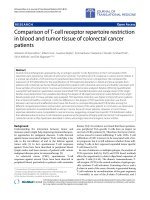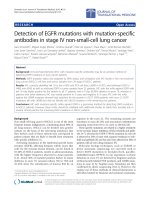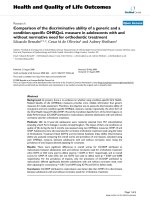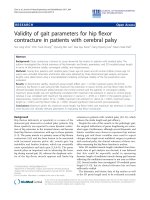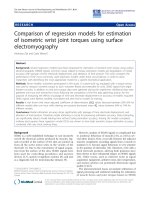báo cáo hóa học:" Comparison of effectiveness of Halo-femoral traction after anterior spinal release in severe idiopathic and congenital scoliosis: a retrospective study" ppt
Bạn đang xem bản rút gọn của tài liệu. Xem và tải ngay bản đầy đủ của tài liệu tại đây (442.21 KB, 7 trang )
BioMed Central
Page 1 of 7
(page number not for citation purposes)
Journal of Orthopaedic Surgery and
Research
Open Access
Research article
Comparison of effectiveness of Halo-femoral traction after anterior
spinal release in severe idiopathic and congenital scoliosis: a
retrospective study
Yong Qiu*, Zhen Liu, Feng Zhu, Bin Wang, Yang Yu, Zezhang Zhu,
Bangping Qian and Weiwei Ma
Address: Spine Surgery, Drum Tower Hospital, Nanjing University Medical School, Nanjing, China
Email: Yong Qiu* - ; Zhen Liu - ; Feng Zhu - ;
Bin Wang - ; Yang Yu - ; Zezhang Zhu - ;
Bangping Qian - ; Weiwei Ma -
* Corresponding author
Abstract
Background: Halo-femoral traction could gradually improve the coronal and sagittal deformity and
restore the trunk balance through the elongation of the spine. The purpose of this retrospective study was
to assess the effectiveness of Halo-femoral traction after anterior spinal release in the management of
severe idiopathic and congenital scoliosis.
Methods: Sixty patients with severe and rigid curve treated with anterior spinal release, Halo-femoral
traction, and second stage posterior spinal fusion were recruited for this retrospective study. Idiopathic
Scoliosis (IS) group was 30 patients (23 females and 7 males) with mean age of 15.5 years. The average
coronal Cobb angle was 91.6° and the mean global thoracic kyphosis was 50.6°. The curve type of these
patients were 2 with Lenke 1AN, 4 with Lenke 1A+, 1 with Lenke 1BN, 10 with Lenke 1CN, 3 with Lenke
1C+, 3 with Lenke 3CN, 3 with Lenke 3C+, and 4 with Lenke 5C+. Congenital Scoliosis (CS) group
included 30 patients (20 females and 10 males) with average age of 15.2 years. The average coronal Cobb
angle of the main curve before operation was 95.7° and the average thoracic kyphosis was 70.2°. All
patients had a minimum 12-month follow-up radiograph (range 12–72 months, mean 38 months).
Results: The average traction time was 23 days and the average traction weight was 16 kg. Four patients
experienced brachial plexus palsy and complete nerve functional restoration was achieved at two months
follow-up. For the IS group, the post-operative mean Cobb angle of major curve averaged 40.1° with
correction rate of 57.5%. For the CS group, the post-operative mean Cobb angle was 56.5° with average
correction rate of 45.2%. The difference in curve magnitude between the IS and CS patients after posterior
correction was statistically significant (t = 4.15, p < 0.001). The correction rate of kyphosis between IS and
CS patients was also statistically significant (t = -2.59, p < 0.016).
Conclusion: Halo-femoral traction was a safe, well-tolerated and effective method for the treatment of
severe and rigid scoliosis patients. The posterior correction rate obtained after anterior release and
traction was significant superior than that recorded from side bending film in current study.
Published: 30 November 2007
Journal of Orthopaedic Surgery and Research 2007, 2:23 doi:10.1186/1749-799X-2-23
Received: 26 December 2006
Accepted: 30 November 2007
This article is available from: />© 2007 Qiu et al; licensee BioMed Central Ltd.
This is an Open Access article distributed under the terms of the Creative Commons Attribution License ( />),
which permits unrestricted use, distribution, and reproduction in any medium, provided the original work is properly cited.
Journal of Orthopaedic Surgery and Research 2007, 2:23 />Page 2 of 7
(page number not for citation purposes)
Background
With the usage of third-generation spinal instrumentation
such as CDH, ISOLA and TSRH, the curve correction
obtained from posterior spinal fusion had a significant
improvement [1,2]. However, the management of severe
and rigid scoliosis remained a big challenge to spine sur-
geon. Preoperative traction could be one option to pro-
vide better correction of the rigid spinal deformity and
minimize neurological complications associated with
forceful intra-operative distraction. Some authors had
studied the usage of Halo-femoral traction as one of the
preparative treatment prior to posterior reconstructive
surgery for severe scoliosis, especially for those with respi-
ratory dysfunction. Halo-femoral traction could gradually
improve the coronal and sagittal deformity and restore the
trunk balance through the elongation of the spine. Respi-
ratory function improvement was also reported [3-5]. The
purpose of this retrospective study was to assess the effec-
tiveness of Halo-femoral traction after anterior spinal
release in the management of severe idiopathic and con-
genital scoliosis.
Methods
A total of 60 patients with severe and rigid curve and with
detailed follow-up data were recruited for this retrospec-
tive study. All these patients were treated with anterior spi-
nal release, halo-femoral traction and second stage
posterior spinal fusion in authors' hospital from August
1998 to May 2005. The inclusive criteria were as follow-
ing: congenital scoliosis or idiopathic scoliosis; halo-fem-
oral traction only performed after one stage anterior
spinal release and removed before posterior surgery; no
history of previous spinal surgery and a minimum postop-
erative follow-up of 12-month. Standing long-cassette
antero-posterior (AP) and lateral radiographs of the
whole spine were taken before anterior surgery, 10 days,
12-month after posterior surgery and at final follow-up
respectively. Coronal Cobb angles were measured on
standing AP film and side bending film. Thoracic kypho-
sis was measured on the lateral radiograph between the
upper endplate of T5 vertebra and the lower endplate of
T12 vertebra using the Cobb method [6]. All patients had
a minimum 12-month follow-up (range 12–72 months,
mean 38 months).
Idiopathic Scoliosis (IS) group included 30 patients (23
females and 7 males). The age at surgery ranged from 10
years to 20 years old with mean age of 15.5 years old. The
average coronal Cobb angle was 91.6° (ranged 70°–
146°), and the mean global thoracic kyphosis was 50.6°
(ranged 26–100°). The curve type of these patients were
analyzed [7], and there were 2 with Lenke 1AN, 4 with
Lenke 1A+, 1 with Lenke 1BN, 10 with Lenke 1CN, 3 with
Lenke 1C+, 3 with Lenke 3CN, 3 with Lenke 3C+, and 4
with Lenke 5C+. Congenital Scoliosis (CS) group had 30
patients (20 females and 10 males). According to the clas-
sification of congenital scoliosis [8], 8 patients were clas-
sified as defect of formation, 6 patients as defect of
segmentation and 16 patients had combined anomaly.
The average age of the patients was 15.2 years (ranged 10–
20). The average coronal Cobb angle of the main curve
was 95.7° (range 70°–150°) and the average thoracic
kyphosis was 70.2° (range 28°–155°) pre-operatively.
All sixty patients received first stage anterior spinal release
with the traditional thoracotomy approach and post-
operative Halo-femoral traction. None of congenital scol-
iosis patients were experienced excision of hemivertebra.
Traction was usually started the second after anterior sur-
gery with a weight of 2 kg and gradually increased at a rate
of 2 to 3 pounds per day if patients well tolerated. The
maximum traction weight could be 33% to 50% of the
whole body weight depending on patients' tolerance.
Traction was applied for a minimum of 12 hours per day,
with the traction weight lessened to 50% in the night.
During the traction, the patient's neurological status was
frequently checked. If hyper reflex of the extremities, Bab-
inski sign, paresthesia, dysfunction of cranial nerves or
any other neurological compromise were noted, the
weight would be immediately reduced. The length of the
traction period was mainly determined by the radio-
graphic evidence of curve improvement on weekly radio-
graphs, in addition to clinical evaluation of the patients'
pulmonary and neurological function. Second stage pos-
terior corrective surgery with CD, CDH or TSRH instru-
mentation were performed after Halo-femoral traction
were removed and all the sixty patients with scoliosis sur-
gically were treated by hybrid constructs with hooks and
screws.
Statistical analysis was performed for each dependent var-
iable comparing the IS versus CS patients by an independ-
ent group's t test. All tests results with P < 0.05 were
considered statistically significant.
Results
The average days with halo-femoral traction were similar
for IS (22 ± 6.3) and CS (25 ± 9.4) patients. The average
traction weight was 16 kg, which accounts for 38% (range
15–50%) of patients' total body weight. Four patients suf-
fered from brachial plexus palsy (1 CS patient and 3 IS
patients), complete nerve function restoration were
achieved at two months follow-up after rehabilitation
training.
No significant differences were found between the two
groups with respect to age or gender distribution. For the
IS group, the average pre-operative major curve magni-
tude was 91.6°(ranged 70°–146°) and decreased to
71.7°(ranged 45°–120°) on side bending (average cor-
Journal of Orthopaedic Surgery and Research 2007, 2:23 />Page 3 of 7
(page number not for citation purposes)
rection rate: 24.3%). The major curve averaged
58.1°(range 37°–90°) at the end of the Halo-femoral
traction treatment and the average correction rate
obtained was 39.3% (ranged 28.6%–50.6%), then
improved to 40.1°(ranged 20°–65°) after posterior cor-
rective surgery. The mean Cobb's angle at final follow-up
was 42.9° (ranged 24°–66°). The mean loss of correction
was 2.9% ± 2.3% (Figure 1).
For the 30 cases with CS, initial coronal Cobb angle aver-
aged 95.7° (range 70°–150°). The curve magnitude on
bending film averaged 73.8° (range 45°–130°) with aver-
age correction rate of 22.5% (ranged 6.5%–37.8%). At the
end of the Halo-femoral traction treatment the Cobb's
angle averaged 68.4°(ranged 40°–115°) and the correc-
tion rate averaged 35.3% (ranged 23.3%–50.0%). The
curve reduced to 56.5° (ranged 35°–110°) immediately
after posterior surgery and to 58.9° (ranged 37°–112°) at
final follow-up. The average loss of correction was 3.2% ±
2.1%. The average pre-operative coronal Cobb angle and
the average time in Halo-femoral traction were similar for
IS and CS patients. The difference in curve magnitude
between the IS and CS patients after posterior correction
was statistically significant (t = 4.15, p < 0.001) (Figure 2).
Improvement on global sagittal alignment was also
observed in IS and CS patients. For IS patients, the mean
preoperative thoracic kyphosis was 50.6° (ranged 26°–
100°), which improved to 30.6° (ranged 22°–50°) after
posterior surgery, and was maintained as 31.6° (ranged
21°–52°) at final follow-up. For CS cases, initial mean
thoracic kyphosis was 70.2° (ranged 28°–155°) and
decreased to 39.0° (ranged 11°–82°) post-operatively.
Before anterior release, the magnitude of thoracic kypho-
sis of CS patients was larger than that of IS cases (t = -2.21,
p = 0.041, Table 1). After posterior surgery, the difference
of the correction rate of kyphosis between IS and CS
patients was also statistically significant (t = -2.59, p <
0.016, Table 1).
Discussion
With the development of the spinal corrective techniques
and the advancement of the instrumentation, severe and
rigid scoliosis which used to be difficult to correct became
manageable. At present, the definition of severe scoliosis
remains controversial. Greiner et al. [9]determined that
AIS patients did not exhibit clinically significant respira-
tory symptoms until their curves were 60 to 100°, so he
defined severe scoliosis as Cobb angle larger than 60°.
Lenke et al. [10] have defined it as Cobb angle ≥ 70°, and
Tokunaga [11] thought that Cobb angle > 80° could be
treated as severe scoliosis. As for the rigid scoliosis, its def-
inition was also unclear until recently. According to
author's clinical experience, the results of one stage poste-
rior surgery for the scoliosis with a coronal Cobb angle
less than 70 degrees and a flexible index on Bending films
more than 40% was satisfactory. Therefore, patients with
severe and rigid scoliosis were recruited in current study
with a coronal Cobb angle larger than 70° and flexible
index on bending films less than 40%.
The aim of the anterior spinal release was to increase spi-
nal flexibility and to improve subsequent correction rate
at posterior instrumentation [12,13]. Tokunaga et al. [11]
reported that staged surgery including anterior release was
an effective surgical method for patients with severe scol-
iosis, where a rigid curve or the risk of neurological com-
plications due to acute forceful correction may exist.
Mehlman et al.[14]also reported that the spinal release
and halo-femoral traction protocol outlined offer a safe,
controlled approach to the reduction of severe spine
deformities before fusion. In current study all the patients
received anterior spinal release first.
Traction as a method of correction of spinal deformity
could be dated back to 3500 BC [15]. Perry and Nickel
first introduced the halo device in 1959 [16] during which
time a jacket or cast was used for caudal support. Then sev-
eral other count-traction methods were invented: halo-
gravity, halo-pelvic and halo-femoral traction [17-19]. In
terms of halo-femoral traction, Kane et al. [20] reported
their series of 30 scoliotic patients in 1967. The average
original curve measured 112° and reduced to 58° after
final correction. Four patients got pin-site irritation and
the pins were reinserted. Paresthesia developed in 3
patients, and 1 had abducens nerve palsy; all the symp-
toms recovered with the reduction of traction forces.
Details about the types of curves treated and specific treat-
ment regimens were not provided in this paper. Bonnett
et al. [21] reported that preoperative halo-femoral traction
resulted in 57% correction of scoliosis as well as 53% cor-
rection of pelvic obliquity in 37 patients with paralytic
scoliosis. Arlet et al. [22] reported on the usage of halo-
femoral traction to treat a 17-year-old girl with congenital
scoliosis of 145° and cor pulmonale. Correction of the
deformity and improvement in pulmonary function were
well achieved. Huang et al. [15] reported on the usage of
intra-operative halo-femoral traction to treat severe scol-
iosis and associated pelvic obliquity in a 14-year-old
patient with cerebral palsy. The patient underwent one
stage anterior and posterior spinal fusion, the posterior
procedure was performed with the patient under halo-
femoral traction. The patient responded well to the surgi-
cal intervention and had a stable correction of his pelvic
obliquity. Mehlman et al. [14] assessed the effectiveness of
spinal release and halo-femoral traction in the manage-
ment of severe spinal deformity in 2004. Twenty-four
patients were treated with halo-femoral traction at the
interval between anterior spinal release and posterior sur-
gery. The etiology of the deformity included IS, CS,
Journal of Orthopaedic Surgery and Research 2007, 2:23 />Page 4 of 7
(page number not for citation purposes)
A 14-year-old girl with idiopathic scoliosis and the Lenke classification was 1C+Figure 1
A 14-year-old girl with idiopathic scoliosis and the Lenke classification was 1C+. A-B: AP radiographs before treatment show-
ing right thoracic scoliosis measured 92°. C:Bending films showed right thoracic scoliosis corrected to 77°. D:The right tho-
racic curve correction obtained with Halo-femoral traction treatment was 40.2%. E-F:The major curve measured 35° after
posterior spinal fusion and the correction rate was 62%. G-H: AP and lateral radiographs at 20-month follow-up showed solid
spinal fusion with a 37° right thoracic curve.
A
B
C
D
E
F
G
H
Journal of Orthopaedic Surgery and Research 2007, 2:23 />Page 5 of 7
(page number not for citation purposes)
A 13-year-old girl with congenital scoliosis with defect of formation and segmentationFigure 2
A 13-year-old girl with congenital scoliosis with defect of formation and segmentation. A-B: AP radiographs before treatment
showed left thoracic scoliosis measured 98° and thoracic kyphosis measured 85°. C:Bending films showed right thoracic scolio-
sis only corrected to 90°. D:The left thoracic curve correction obtained with Halo-femoral traction was 24.1%. E-F:The major
curve measured 50°after posterior spinal fusion with correction rate of 49.0%. The correction rate of kyphosis was 47.1%. G-
H: AP and lateral radiographs at 18-month follow-up showed solid spinal fusion with a 53°left thoracic curve and a 45° thoracic
kyphosis.
A
B
C
D
E
F
G
H
Journal of Orthopaedic Surgery and Research 2007, 2:23 />Page 6 of 7
(page number not for citation purposes)
Scheuermann's kyphosis, Neuromuscular scoliosis, and
Osteogenesis imperfecta. The correction obtained after
Halo-feromal traction averaged 59% (ranged 14–100%).
In current series, compared with CS with similar curve
magnitude, the patients with severe and rigid idiopathic
scoliosis were slightly more flexible on side bending film
(IS 24.3% correction vs. CS 22.5%). Curve correction
obtained after traction has a significant improvement
when compared with the correction obtained from side
bending film in our study. This statistically significant dif-
ference confirms the efficacy of the technique of Halo-
femaral traction. We also found that the average correc-
tion obtained from posterior fusion was 57.5% in IS
group, significantly higher than that in CS group (45.2%,
p < 0.001). Current results demonstrated less overall curve
correction rate when compared with the reports of Kane et
al. [20], Bonnett et al. [21] and Mehlman et al. [14]. This
may be due in part to lower traction forces used in our
study (only 36% of the average body weight) than Mehl-
man study (54% of the average body weight). Further-
more, the curves in Kane and Bonnett's study were less
rigid than current study.
Leatherman [23] first described a two-stage procedure for
the treatment of congenital scoliosis. In his study, the
mean curve correction obtained after the second stage was
45.6% and the correction of kyphosis was 44.4%.
Author's results demonstrate that after posterior surgery
the curve correction obtained averaged 45.2% and the
thoracic kyphosis magnitude decreased to 39.0° (ranged
11°–82°) with average correction rate of 43.5%.
Although the curve correction rate in two studies were
similar, the initial curve angel of CS patients in current
study were far more serious than that in Leatherman's
study. Therefore we could conclude that Halo-femaral
traction had a enormous effectiveness for the correction of
patients with severe and rigid congenital scoliosis.
Severe coronal curve usually associated with significant
deformity on sagittal plane. In current study, twenty-three
patients with IS and twenty-five CS patients had pre-oper-
ative thoracic kyphosis (T5–T12 > 40°). Compared with
the IS patients, the mean pre-operative thoracic kyphosis
for CS was significant higher (70.2° vs. 50.6°). Combined
with Halo-femoral traction, modern spinal instrumenta-
tion system provided good correction on sagittal plane for
severe scoliosis. Thoracic kyphosis of patients in our study
corrected well after posterior surgery, especially for CS
patients.
Complications related to the halo itself included pin loos-
ening, superficial, and deep pin tract infections. Brain
abscess has also been previously described with halo pins
[24]. Halo-femoral traction compiled certain neurological
complications [25]. Rinella [26] reported a total of 42
consecutive patients with severe operative scoliosis,
kyphoscoliosis, or kyphosis treated with halo-gravity trac-
tion. Triceps palsy (2.38%), and brachial plexus palsy
(2.38%) occurred during halo traction. Traction-related
complications were also encountered in our study. In the
present study, 4 cases suffered from brachial plexus palsy
(1 CS patients, 3 IS patients). All patients restored their
complete neural function at two months follow-up. The
most likely cause of the injury was thought to be due to
the hyper-abduction of the arm and over-stretched of the
brachial plexus. Brachial plexus palsy associated with
Halo-femoral traction in severe and rigid scoliosis was a
temporary, revertible damage to nerve function. If the
symptoms were promptly detected and rehabilitation
training and appropriate medication were prescribed
timely, complete nerve functional restoration could be
achieved.
Spinal cord injury and paralysis were the most serious
complications of spinal corrective surgeries. Cotrel [27]
reported that the incidence was 0.8%. Patients with severe
and rigid scoliosis were thought to be at greater risk of
these complications. Some authors advocated rapid cor-
rection via one stage anterior release and posterior surgery
for patients with severe scoliosis without an intervening
period of traction [28]. Long term follow-up and big sam-
ple size were mandatory to support these one-stage or
"rapid correction" conception. Our results showed that
Table 1: Clinical datas of the IS and CS groups
Group n Time in
Halo-femoral
traction(days)
Initial Coronal
Cobb Angle (°)
Thoracic
Kyphosis
(T5–T12,°)
Curve
Correction
With Bending
film(%)
Cobb Correction
After Halo-Femoral
Traction (%)
Cobb
Correction
After
Posterior
Fusion(%)
Thoracic
Kyphosis
correction
After Posterior
Fusion
(T5–T12, %)
Loss of
Correction
(Coronal%)
Loss of
Correction
(Sagittal%)
IS 30 22 ± 6.3 91.6 ± 20.1 50.6 ± 18.4 24.3 ± 8.2 39.3 ± 6.24 57.5 ± 8.37 33.7 ± 12.8 2.9 ± 2.3 2.3 ± 2.1
CS 30 25 ± 9.4 95.7 ± 24.5 70.2 ± 34.3 22.5 ± 11.7 35.3 ± 7.27 45.2 ± 8.97 43.5 ± 14.2 3.2 ± 2.1 2.5 ± 1.9
t - -0.25 -0.27 -2.21 1.34 1.36 4.15 -2.59 -0.73 -1.38
p - 0.64 0.81 0.041* 0.19 0.18 <0.001* 0.016* 0.28 0.18
*:p < 0.05
Publish with BioMed Central and every
scientist can read your work free of charge
"BioMed Central will be the most significant development for
disseminating the results of biomedical research in our lifetime."
Sir Paul Nurse, Cancer Research UK
Your research papers will be:
available free of charge to the entire biomedical community
peer reviewed and published immediately upon acceptance
cited in PubMed and archived on PubMed Central
yours — you keep the copyright
Submit your manuscript here:
/>BioMedcentral
Journal of Orthopaedic Surgery and Research 2007, 2:23 />Page 7 of 7
(page number not for citation purposes)
Halo-femoral traction was a safe, well-tolerated and effica-
cious method in the treatment of this formidable disease.
Combined with anterior spinal release and posterior
fusion, it could notably reduce the incidence of severe
complication such as spinal cord injury, at the time of
good correction of severe spinal deformity. In addition,
curve correction obtained after traction was significantly
superior than that achieved on side bending film in cur-
rent study, therefore the pre-operative side bending radi-
ography may not able to accurately predict the correction
rate of posterior instrumentation for severe scoliosis.
Conclusion
Halo-femoral traction was a safe and effective method for
the treatment of severe idiopathic and congenital scoliosis
patients, especially for IS patients. The posterior correc-
tion rate obtained after anterior release and traction was
significant superior than that recorded from side bending
film in current study.
Competing interests
The author(s) declare that they have no competing inter-
ests.
Acknowledgements
The research was approved by Ethic Committee of Nanjing University.
References
1. Benli IT, Aka S, Kis M, Citak M, Aydin E, Duman E: Frontal and sag-
ittal balance analysis of late onset idiopathic scoliosis treated
with third generation instrumentation. Kobe J Med Sci 2001,
47:231-253.
2. Suk SI, Kim WJ: Indications of proximalthoracec curve fusion
in thoracic adolescent idiopathic scoliosis: recognition and
treatment of double thoracic curve pattern in adolescent idi-
opathic scoliosis treated with segmental instrumentation.
Spine 2000, 25:2342-2350.
3. Sink EL, Karol LA, Sanders J, Birch JG, Johnston CE, Herring JA: Effi-
cacy of perioperative Halo-gravity traction in the treatment
of severe scoliosis in children. J Pedia Orthop 2001, 21:519-524.
4. Qian BP, Qiu Y, Wang B: Brachial plexus palsy associated with
halo traction before posterior correction in severe scoliosis.
Stud Health Technol Inform 2006, 123:538-542.
5. Liljenqvist U, Lepsien U, Hackenberg L, Niemeyer T, Halm H: Com-
parative analysis of pedicle screw and hook instrumentation
in posterior correction and fusion of idiopathic thoracic sco-
liosis. Eur Spine J 2002, 11:336-343.
6. Cobb J: Outline for the study of scoliosis. AAOS Instr Course Lect
1948, 5:261-275.
7. Lenke LG, Betz RR, Harms J, Bridwell KH, Clements DH, Lowe TG,
Blanke K: Adolescent idiopathic scoliosis: a new classification
to determine extent of spinal arthrodesis. J Bone Joint Surg Am
2001, 83–A(8):1169-1181.
8. McMaster MJ, Ohtsuka K: Thenatural history of congenital sco-
liosis. A study of two hundred and fifty one patients. J Bone
Joint Surg Am 1982, 64:1128-1147.
9. Greiner KA: Adolescent idiopathic scoliosis: radiologic deci-
sion-making. Am Fam Physician 2002, 65:1817-1822.
10. O'Brien MF, Lenke LG, Bridwell KH, Blanke K, Baldus C: Preopera-
tive spinal canal investigation in adolescent idiopathic scolio-
sis curves ≥70°. Spine 1994, 19:1606-1610.
11. Tokunaga M, Minami S, Kitahara H, Isobe K, Nakata Y, Moriya H:
Vertebral decancellation for severe scoliosis. Spine 2000,
25:469-474.
12. Newton PO, Wenger DR, Mubarak SJ, Meyer RS: Anterior release
and fusion in pediatric spinal deformity. A comparison of
early outcome and cost of thoracoscopic and open thoraco-
thmy approaches. Spine 1997, 12:1398-1409.
13. Newton PO, Shea KG, Granlund KF: Defining the pediatric spinal
thoracoscopy learning curve : sixty-five consecutive cases.
Spine 2000, 25:1028-1035.
14. Mehlman CT, Al-Sayyad MJ, Crawford AH: Effectiveness of Spinal
Release and Halo-Femoral Traction in the Management of
Severe Spinal Deformity. J Pediatr Orthop 2004, 24:667-673.
15. Huang MJ, Lenke LG: Scoliosis and severe pelvic obliquity in a
patient with cerebral palsy: surgical treatment utilizing halo-
femoral traction. Spine 2001, 26:2168-2170.
16. Nickel V, Perry J, Garrett A: The halo – a spinal skeletal traction
fixation device. J Bone Joint Surg Am 1968, 50:1400-1409.
17. Dewald RL, Ray RD: Skeletal traction for the treatment of
severe scoliosis. The University of Illinois halo-hoop appara-
tus. J Bone Joint Surg Am 1970, 52:233-238.
18. Edgar MA, Chapman RH, Glasgow MM: Pre-operative correction
in adolescent idiopathic scoliosis. J Bone Joint Surg Br 1982,
64:530-535.
19. Floman Y, Penny JN, Micheli LJ, Riseborough EJ, Hall JE: Osteotomy
of the fusion mass in scoliosis. J Bone Joint Surg Am 1982,
64:1307-1316.
20. Kane WJ, Moe JH, Lai CC: Halo-femoral pin distraction in the
treatment of scoliosis. J Bone Joint Surg Am 1967, 49:1018-1019.
21. Bonnett C, Perry J, Brown JC, Greenberg BJ: Halo-femoral distrac-
tion and posterior spine fusion for paralytic scoliosis. J Bone
Joint Surg Am 1972, 54-A:202.
22. Arlet V, Papin P, Marchesi D: Halo femoral traction and sliding
rods in the treatment of a neurologically compromised con-
genital scoliosis:technique. Eur Spine J 1999, 8:329-331.
23. Leatherman KD, Dickson RA: Two stage corrective surgery for
congenital deformity of the spine. J Bone Joint Surg Br 1978, 61–
B(3):324-328.
24. Celli P, Palatinsky E: Brain abscess as a complication of cranial
traction. Surg Neurol 1985, 23:594-596.
25. MacEwen GD, Bunnell WP, Sriram K: Acute neurological compli-
cations in the treatment of scoliosis. A report of the Scoliosis
Research Society. J Bone Joint Surg Am 1975, 57:404-408.
26. Rinella A, Lenke L, Whitaker C, Kim Y, Park SS, Peelle M, Edwards C
II, Bridwell K: Perioperative halo-gravity traction in the treat-
ment of severe scoliosis and kyphosis. Spine 2005, 30:475-482.
27. Cotrel Y, Dubousset J, Guillaumat M: New universal instrumen-
tation in spinal surgery. Clin Orthop 1988, 227:10-23.
28. Li M, Liu Y, Zhu X, Bai Y, Ni C, Shi Z, Hou T: Surgical results of
one stage anterior release and posterior correction for
treatment of severe scoliosis. Chin J Orthop 2004, 24:271-275.


